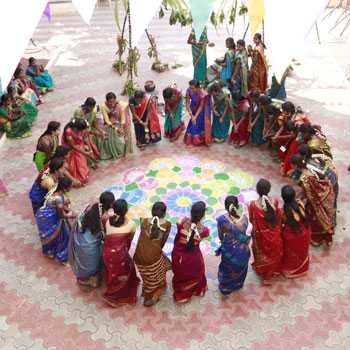PONGAL TRADIONAL DANCE KUMMI : Kummi dance is one of the most important and ancient forms of village dances of Tamil Nadu state of India. It reflects the day-to-day life of villagers of Tamil Nadu.
History of Kummi Dance Kummi dance originated during a period when there were no musical instruments. The term Kummi is said to be derived from the word ‘Kommai’ which means to ‘dance with clapping of hands’ to time Performance of Kummi
Kummi is usually performed by a group of Tamil women in a circle. This folk dance however assumes different forms. In some places, it is very simple, with rhythmic clapping while in other places the group of dancers imitate various harvesting activities.
In the simple Kummi dance, the women stand in a circle and dance clapping their hands rhythmically. The dance steps are also repetitive; they hold hands, move forward, bend down and clap their hands. One of the women leads the singing with a favourite song while the rest take up the dance. Each performer sings a new line in turn and the dance stops when all get tired. Facial expressions play an important role in Kummi dance.
In some local variation of the Kummi dance, men are also seen participating along with the women. In this type of dance, the men form a circle with sticks in their hands, inside which the women stand in a smaller ring. The main thing to be enjoyed in this dance form is the synchronization between clapping of the hands by the women and the beating of the sticks by men. Kummi dance is performed in accompany of “Kummi songs”. Kummi songs became a popular addition to kuthiyottam festivities in modern times. Kummi can be practiced in different styles such as Poonthatti Kummi, Deepa Kummi, Kulavai Kummi, Kadir Kummi, Mulaipari Kummi, etc.

